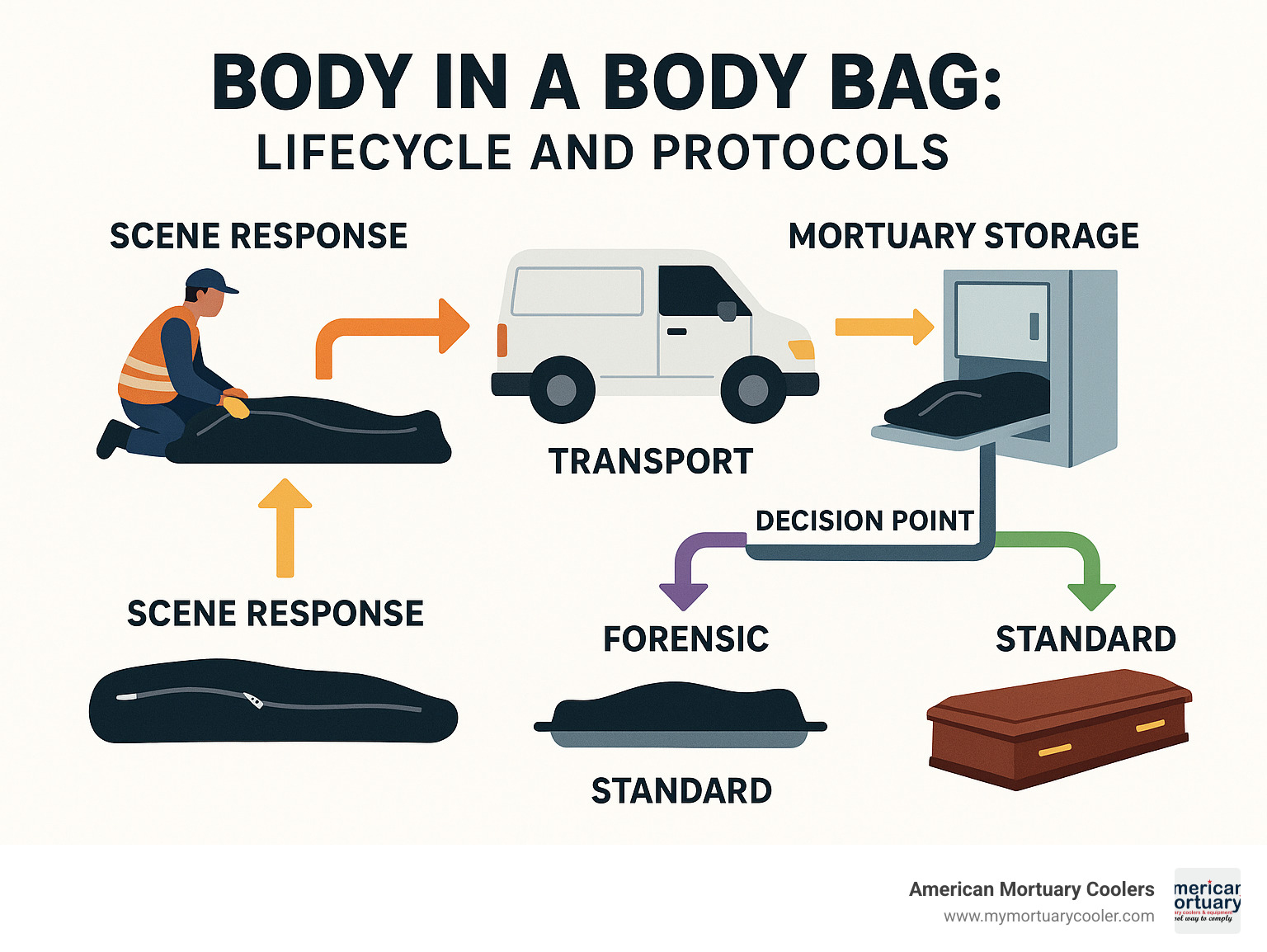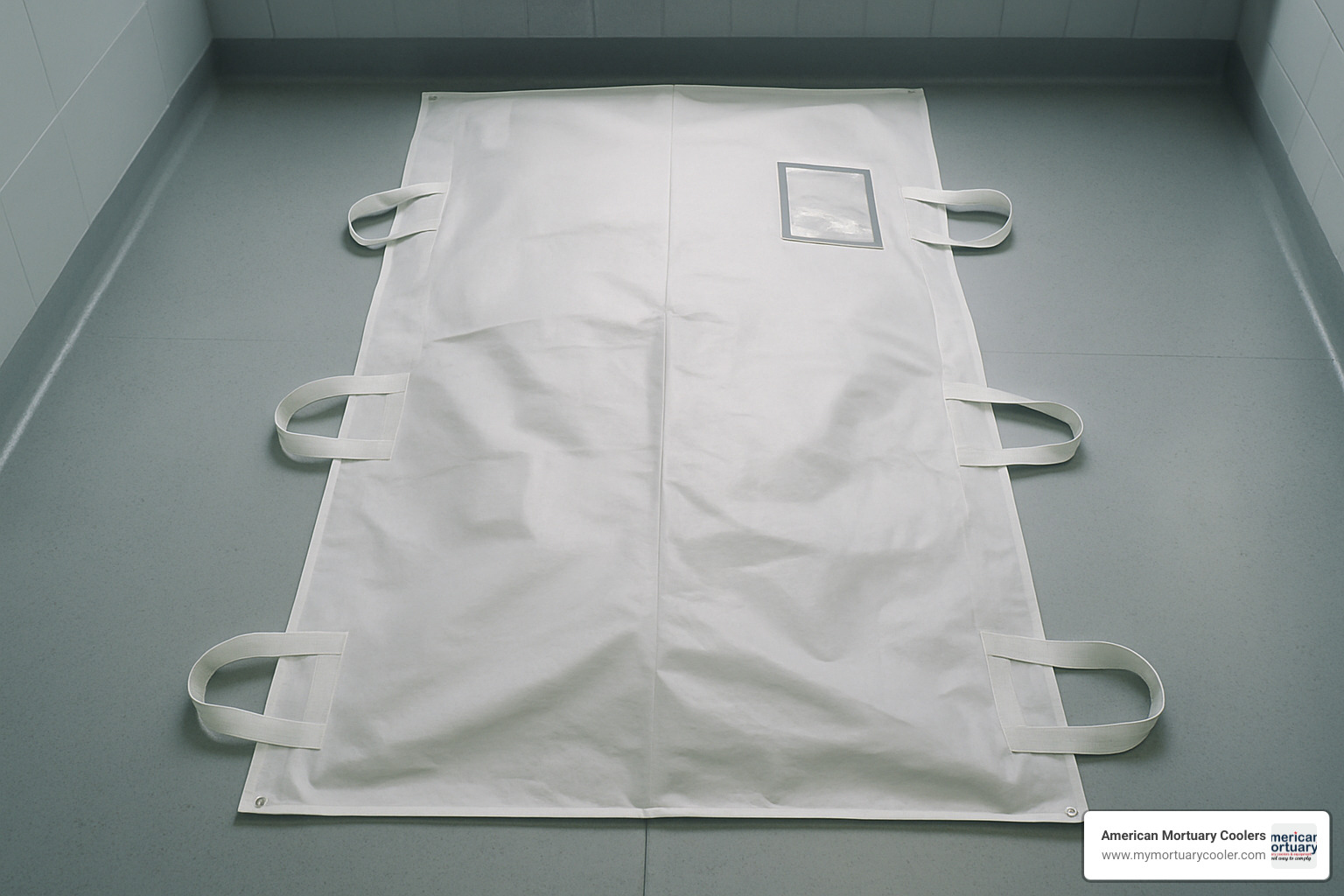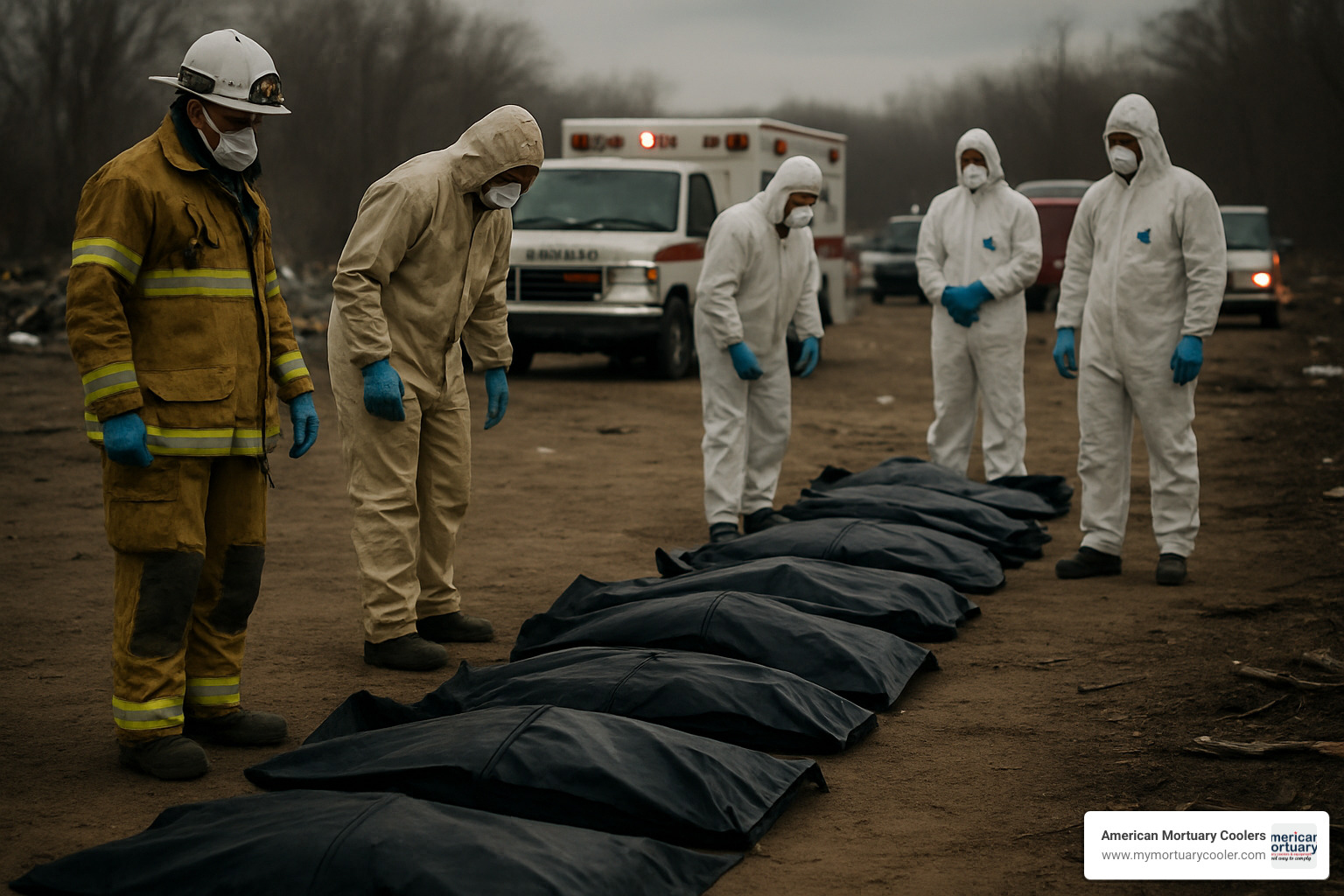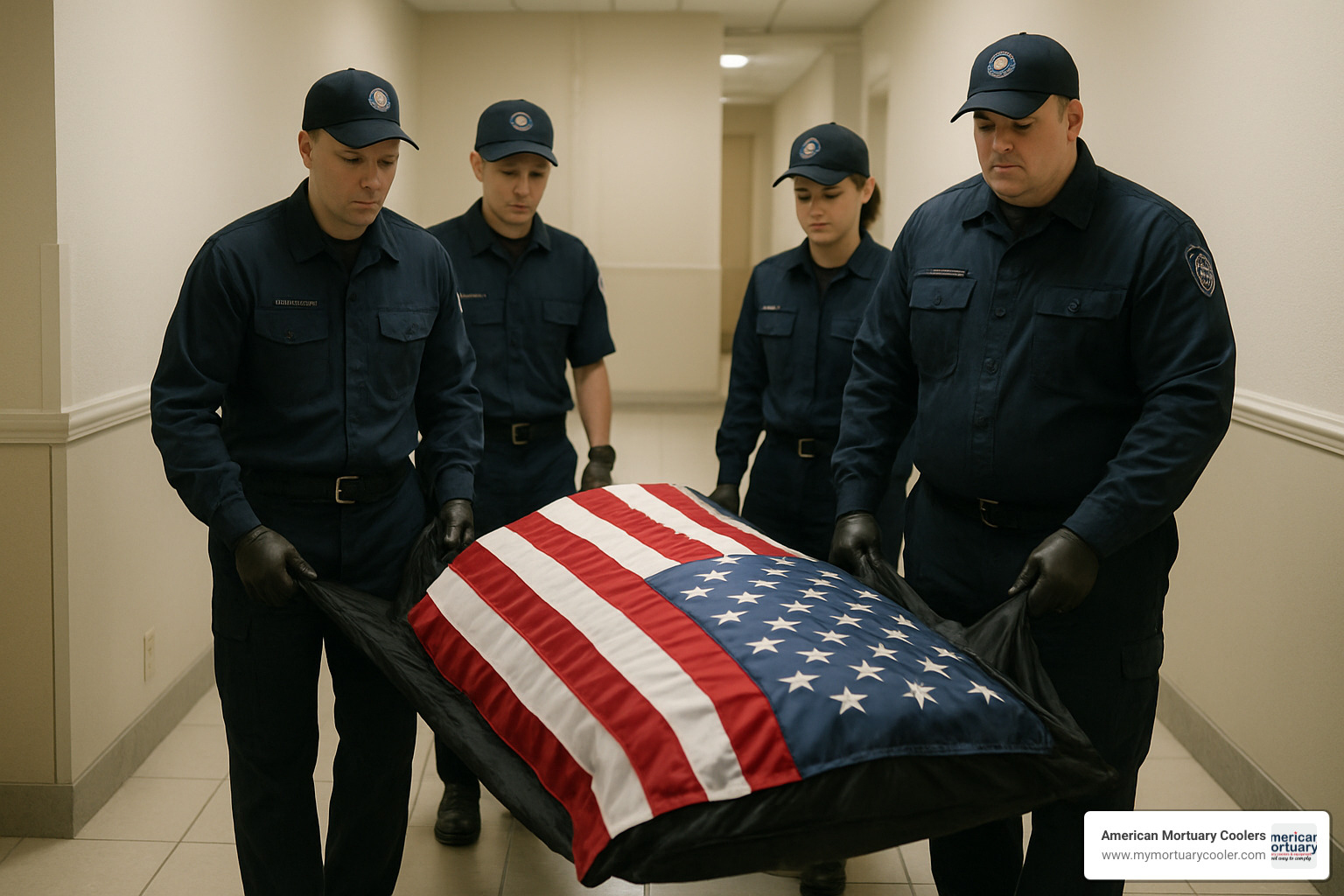Why Understanding Body Bags Matters for Mortuary Professionals
A body in a body bag is the standard method for containing, transporting, and storing human remains across multiple contexts - from crime scenes to hospitals, disaster sites to funeral homes. Here's what every mortuary professional needs to know:
Key Facts About Bodies in Body Bags:
- Primary purpose: Leak-proof containment and dignified transport of deceased individuals
- Standard dimensions: Typically 36" x 90" with weight capacity up to 400 pounds
- Material: Usually 6-8 mil thick PVC or vinyl with reinforced zippers
- Color coding: Black for standard use, white for forensic evidence collection, yellow for infectious disease control
- Single-use design: Prevents contamination and maintains chain of custody
The demand for body bags surged 600% during the COVID-19 pandemic, highlighting their critical role in public health emergencies. Modern body bags evolved from the first patent filed in 1863 during the Civil War to today's sophisticated leak-proof designs that protect both the deceased and those handling them.
When Bodies Are Placed in Body Bags:
- Hospital and nursing home deaths
- Crime scene investigations
- Mass casualty events and natural disasters
- Military operations and combat zones
- Infectious disease outbreaks
- Transport between facilities
I'm Mortuary Cooler, a national-level mortuary cooler supplier with experience in mortuary equipment and protocols. Understanding proper handling of a body in a body bag is essential for maintaining dignity, safety, and regulatory compliance in our industry.

Body in a body bag terms simplified:
The Reality of a Body in a Body Bag: Purpose and Design
The story of the body in a body bag begins on a Civil War battlefield in 1863. Dr. Thomas Holmes, faced with the grim reality of war casualties, filed the first patent (No. 39,291) on July 21, 1863, for an "Improvement in Receptacles for Dead Bodies." His innovation wasn't just about convenience—it was about bringing dignity to chaos and protecting the living while honoring the dead.
Today's body bags have evolved far beyond Dr. Holmes' original design, but they serve the same fundamental purpose. What we now call cadaver pouches or human remains pouches (HRP) are sophisticated pieces of equipment designed with care and precision.
Modern body bags create a leak-proof barrier that contains bodily fluids, protecting everyone involved in transport and handling. They provide dignity and privacy by shielding the deceased from public view during what can be a vulnerable time for families. The public health protection they offer is crucial—these bags act as barriers against potential infectious agents that could harm first responders, medical staff, and funeral professionals.
The design details matter more than you might think. Reinforced handles are strategically placed at corners and edges to distribute weight safely during lifting. Zipper styles vary depending on the intended use—straight zippers for standard cases, J-shaped for easier access, and D-shaped for specialized situations. Color coding isn't arbitrary either, with different colors serving specific purposes we'll explore below.
Weight capacity ranges from 200 pounds for basic models up to 450 pounds for heavy-duty disaster-grade versions. These aren't one-size-fits-all solutions—they're carefully engineered for different scenarios and needs.
Why a "body in a body bag" is Standard at Crime Scenes
When investigators arrive at a crime scene, placing a body in a body bag isn't just protocol—it's essential for justice. The chain of custody requirements mean that every piece of evidence must remain uncontaminated from the moment it's collected until it reaches the courtroom.
Here's where color makes all the difference. White body bags are the gold standard for forensic work because any dropped evidence shows up clearly against the white background. Try spotting a small fiber or piece of metal against a black surface in low light—it's nearly impossible. White bags turn the container itself into a evidence-collection tool.
The leak-proof design prevents cross-contamination between different pieces of evidence, while the single-use nature ensures that no materials from previous cases could interfere with the current investigation. Scientific research on forensic evidence retention consistently shows that proper body bag protocols significantly improve evidence preservation rates.
Most courts now accept properly prepared, unused body bags as evidence containers themselves. This dual-purpose functionality makes them invaluable tools for both transport and forensic collection, creating a sealed environment that protects trace evidence from environmental contamination during transport to laboratory facilities.
"Body in a Body Bag" During Mass-Fatality Disasters
When disaster strikes, the need for body bags can increase dramatically and suddenly. During the Falklands War, British forces used gray plastic body bags for temporary mass graves before later exhumation—a grim but necessary protocol in wartime conditions.
The COVID-19 pandemic created unprecedented demand that caught many facilities off guard. Morgues overflowed, requiring temporary storage facilities and emergency stockpiling of body bags nationwide. Our team at American Mortuary Coolers witnessed how critical the relationship between proper body bag protocols and effective morgue storage solutions becomes during crisis situations.
When traditional morgue capacity is exceeded, proper body bag containment becomes absolutely essential for maintaining dignity and safety in temporary storage areas. It's not just about logistics—it's about treating every person with respect, even in the most challenging circumstances.
Disaster scenarios often require specialized oversized bags—typically 54" x 108"—to handle challenging recovery conditions. These heavy-duty versions feature envelope-style openings and reinforced strap handles specifically designed for first responders working in difficult environments where standard equipment might fail.
Materials, Evolution & Environmental Considerations

The materials used for a body in a body bag have come a long way since the first crude designs. Today's body bags are marvels of practical engineering, built to handle the most challenging situations while keeping everyone safe.
Most modern body bags use high-density 6-8 mil virgin PVC or vinyl as their foundation. This might sound technical, but it simply means the plastic is thick enough to prevent tears and completely leak-proof. The embossed surface adds extra strength, while heat-sealing on all four sides creates an impenetrable barrier.
The reinforced curved zippers deserve special mention - they feature dual rust-proof pulls and locking loops that won't fail when you need them most. After all, nobody wants a zipper malfunction during a difficult situation.
Different materials serve specific needs in the field. PVC and vinyl remain the gold standard for most mortuary work because of their excellent fluid containment. Mesh materials might seem counterintuitive, but they're essential for underwater recoveries where drainage is needed while maintaining containment. Polyethylene offers a lighter weight option when dealing with mass casualty scenarios where every ounce matters.
Some manufacturers now add antimicrobial coatings to provide improved protection against pathogen transmission - a lesson learned during recent health crises.
Weight capacity varies dramatically based on construction quality. Mass casualty bags typically support up to 200 pounds and cost around $10 each. Disaster-grade bags can handle up to 450 pounds but cost $45-75 each. The single-use design prevents hygiene issues and evidence contamination, with disposal typically through incineration.
| Feature | Cotton Shrouds (Historical) | Modern Plastic Body Bags |
|---|---|---|
| Fluid Containment | Poor - absorbs but doesn't contain | Excellent - 100% leak-proof |
| Durability | Tears easily when wet | Puncture-resistant up to 450 lbs |
| Cost | $5-15 | $10-75 depending on grade |
| Hygiene | Reusable but contamination risk | Single-use, eliminates cross-contamination |
| Evidence Preservation | Poor - fibers can transfer | Excellent - sealed environment |
From Canvas to High-Tech Polymers
The journey from Civil War-era canvas tarps to today's sophisticated polymers tells a fascinating story of innovation born from necessity. Those early canvas coverings were little more than glorified tarps - they provided basic dignity but offered practically no protection for handlers or the environment.
World War II brought cotton covers that were a step up from canvas, but still fell short of what we needed. Anyone who's worked with wet cotton knows it becomes heavy, tears easily, and creates more problems than it solves.
The 1970s introduced rubberized materials that seemed promising at first. However, these early attempts proved inferior to current plastic designs. The rubber would crack in cold weather, tear under stress, and didn't provide reliable fluid containment.
Today's 6-8 mil PVC construction with antimicrobial coatings represents the current state-of-the-art. This thickness strikes the perfect balance between durability, safety, and cost-effectiveness. The embossed surface texture adds strength while the virgin material ensures no contamination from recycled sources.
Green Future for Body Bags
Environmental responsibility is becoming increasingly important in our industry, and body bag manufacturing is no exception. Biodegradable film trials show real promise for reducing long-term environmental impact, though we're still working through the technical challenges.
EU waste directives are pushing manufacturers toward more sustainable options, and American companies are following suit. Types of Plastic Body Bags research indicates growing interest in recyclable alternatives, though safety and contamination concerns currently limit widespread adoption.
Carbon footprint audits of body bag manufacturing reveal opportunities for improvement in both materials sourcing and end-of-life disposal. Some forward-thinking facilities are piloting reusable outer shells with disposable inner liners - an innovative approach that could reduce waste while maintaining safety standards.
The challenge lies in balancing environmental responsibility with the non-negotiable requirements of safety, dignity, and regulatory compliance. As the industry evolves, we're optimistic that sustainable solutions will emerge without compromising the essential function of keeping every body in a body bag properly protected and respectfully handled.
Protocols & Procedures: Handling a Body Bag Across Contexts

When it comes to handling a body in a body bag, proper protocols can mean the difference between maintaining dignity and creating additional trauma for families. Every mortuary professional knows that these procedures aren't just about following rules - they're about showing respect during someone's most difficult moments.
The reality is that protocols vary dramatically depending on the situation. A body in a body bag at a hospital death follows different procedures than one at a crime scene or disaster site. However, certain safety principles remain constant across all contexts.
OSHA's universal precautions for blood-borne pathogens govern every aspect of body bag handling. This means appropriate PPE including gloves, gowns, and eye protection are non-negotiable, regardless of the circumstances. These aren't suggestions - they're legal requirements that protect both workers and the public.
The basic approach starts with scene assessment before anyone touches anything. Environmental hazards, space constraints, and the condition of remains all influence which protocols apply. From there, proper PPE donning sets the stage for everything that follows.
Documentation requirements can't be overlooked either. Every time rigor mortis gets broken during placement, it needs recording. The condition of remains gets noted. Chain of custody paperwork stays current. These details matter later when families have questions or legal issues arise.
Transport to refrigerated storage should happen as quickly as possible, even though the body bag's oxygen-restricting environment slows decomposition. The goal is maintaining dignity while protecting everyone involved.
Step-by-Step: Securing and Moving the Deceased
Professional handling of a body in a body bag follows a specific sequence that experienced mortuary staff know by heart. The process begins with scene assessment - evaluating environmental hazards and determining which type of bag the situation requires.
PPE protocol comes next, with full protective equipment per OSHA standards. This isn't the time to cut corners or skip steps. Once properly protected, bag preparation involves unzipping completely, attaching identification tags, and positioning everything for easy access.
The body positioning phase requires proper lifting techniques while maintaining dignity throughout the process. This is often the most challenging part, especially when families are present or when dealing with difficult circumstances.
Closure process means zipping carefully to ensure no clothing or tissue gets caught. Nothing disrupts the process more than having to reopen a bag because something went wrong during sealing.
The identification pocket typically measures 6 inches by 8 inches and accommodates standard documentation. Three identification tags provide the redundancy needed for proper tracking. Documentation completion covers all required paperwork and evidence logs before any transport begins.
Finally, transport to appropriate storage uses proper lifting equipment and techniques. Our experience with compassionate transportation has taught us that maintaining dignity throughout this entire process makes a real difference for grieving families.
Special Protocols for Infectious Remains
Infectious disease cases require improved protocols when placing a body in a body bag. The double-bagging procedure uses an inner leak-proof bag followed by an outer containment layer. This isn't overkill - it's necessary protection for everyone involved in the process.
Yellow bags specifically indicate infectious disease control, immediately alerting all handlers to take improved precautions. Color coding saves lives by preventing accidental exposure.
CDC guidance during the COVID-19 pandemic established specific protocols for respiratory illness victims. This included disinfectant wipes for external surfaces and specialized ventilation requirements during handling. These protocols proved essential for protecting mortuary staff while maintaining proper care for the deceased.
The pandemic taught us that infectious disease protocols aren't just theoretical exercises. When done correctly, they protect workers, families, and the broader community while still honoring the deceased with dignity and respect.
Psychological, Ethical & Cultural Dimensions
When families see a body in a body bag, the emotional impact runs deeper than most people realize. Grief counselors tell us that some families find comfort in the professional appearance - it shows their loved one is being handled with care. But for others, that clinical plastic barrier feels cold and impersonal, adding another layer to their trauma.
First responders face their own struggles with repeated exposure to body bags. EMTs, police officers, and military personnel often develop what psychologists call "compassion fatigue" after handling multiple casualties. The sight of rows of body bags during disasters like COVID-19 or natural catastrophes can trigger lasting mental health effects that require professional support.
Media coverage creates another ethical minefield. News outlets walk a fine line between documenting important events and respecting the dignity of the deceased. Those stark images of body bags can inform the public about serious situations, but they can also traumatize viewers and violate the privacy rights of families who never consented to such exposure.
Religious and cultural traditions add another layer of complexity. What seems like standard protocol to mortuary professionals might conflict deeply with centuries-old burial customs and beliefs about proper treatment of the dead.
Balancing Dignity and Documentation

Professional mortuary work requires constant balance between practical needs and human dignity. When documentation photos are necessary, ethical protocols blur identifying features while preserving evidence value. This protects both the deceased and their families from unwanted exposure.
Timing matters enormously when it comes to family notification. Many funeral directors now coordinate with law enforcement to ensure families are properly informed before any media coverage might show body bags from accident or crime scenes. It's a small consideration that makes a huge difference during families' worst moments.
Journalism ethics have evolved significantly around body bag imagery. Major news outlets increasingly limit such coverage unless it's absolutely essential for public understanding. The military's use of terms like "transfer tubes" instead of "body bags" reflects this growing sensitivity around language and public perception.
The goal is always to maintain professional standards while honoring human dignity. Every person deserves respect, even in death, and that principle guides how we handle both the physical process and the documentation requirements.
Cultural Perspectives on Viewing a Body in a Body Bag
Different cultures bring vastly different perspectives to the sight of a body in a body bag. These differences aren't just preferences - they're deeply held beliefs about what constitutes proper care for the deceased.
Islamic traditions emphasize ghusl (ritual washing) and careful shrouding with white cloth. When forensic requirements mandate body bags, Islamic families often experience real distress. The plastic barrier can feel like it prevents proper spiritual preparation for the afterlife. Many funeral homes now work with Islamic communities to find compromises that respect both legal requirements and religious needs.
Jewish tahara preparations involve ritual washing and dressing that traditionally occurs before any containment. Orthodox families may request delays or special accommodations to complete these sacred duties. The tension between modern mortuary practices and ancient traditions requires sensitive navigation by funeral professionals.
Military customs have found powerful ways to honor tradition within practical constraints. Flag draping over body bags for fallen service members creates deeply moving imagery that respects sacrifice while maintaining necessary containment protocols. These ceremonies remind us that dignity and practicality can coexist.
Buddhist perspectives often accept body bags as practical necessity while emphasizing the temporary nature of physical form. This philosophical approach can actually ease family acceptance of modern mortuary practices.
Interfaith disaster response teams have become experts at balancing diverse needs during mass casualty events. They've developed protocols that honor various cultural traditions within public health requirements. Sometimes this means adjusting timing for religious rituals, or providing ceremonial elements that respect traditions while maintaining safety standards.
Understanding these cultural dimensions helps mortuary professionals serve families with greater compassion and effectiveness. Every tradition has wisdom about honoring the dead - our job is finding ways to respect that wisdom within modern realities.
Frequently Asked Questions about Body Bags
Do body bags stop decomposition completely?
Body bags don't stop decomposition completely - they're designed for containment and transport, not preservation. While placing a body in a body bag does slow the process through oxygen restriction, anaerobic bacteria inside the body continue working regardless of external barriers.
The partial vacuum created by a sealed body bag limits aerobic bacterial activity, which helps slow some aspects of decomposition. However, the bag material can actually trap heat when exposed to sunlight or warm environments, potentially speeding up internal temperature changes that accelerate decomposition.
That's why we always recommend prompt transfer to temperature-controlled morgue facilities, even when remains are properly contained in body bags. The bag serves as your first line of defense for safety and dignity, but proper refrigeration remains essential for preservation.
Are body bags ever reused?
Body bags are strictly single-use items and should never be reused under any circumstances. The health risks and legal implications make reuse completely unacceptable in professional mortuary practice.
Hygiene concerns top the list of reasons why a body in a body bag requires fresh containment every time. Infectious agents could transfer between cases, putting staff and families at serious risk. Beyond health concerns, reusing body bags could contaminate forensic evidence and compromise legal proceedings.
Some facilities have experimented with reusable outer shells combined with disposable inner liners, but current safety standards and regulations strongly favor complete single-use systems. Given the relatively modest cost of modern body bags, single-use protocols make both economic and safety sense.
What legal standards govern body-bag manufacturing?
Body bag manufacturing falls under multiple regulatory frameworks rather than one comprehensive standard. OSHA's universal precautions for blood-borne pathogen protection provide the foundation, while various state health departments add their own requirements.
Most manufacturers follow medical device guidelines for materials safety and construction quality, even though body bags aren't technically medical devices. Military specifications often serve as industry benchmarks for strength and durability - if it's good enough for combat conditions, it works for civilian applications.
Forensic applications require additional considerations for evidence containment and chain of custody. International standards vary significantly, with EU waste directives increasingly pushing manufacturers toward more environmentally conscious designs.
At American Mortuary Coolers, we ensure all our storage solutions meet applicable regulations for safe body in a body bag containment and handling. Our experience with mortuary equipment helps funeral homes steer these complex requirements while maintaining the highest safety standards.
Conclusion
Working with a body in a body bag is more than just following protocols - it's about honoring the dignity of every person who has passed while protecting those who care for them. From that first patent filed during the Civil War in 1863 to today's advanced leak-proof designs, these essential tools have evolved to meet our most challenging moments.
The pandemic taught us just how crucial proper body bag systems really are. When demand jumped 600% almost overnight, facilities across the country scrambled to maintain their standards of care. Whether you're handling a quiet passing at a nursing home, working a complex forensic case, or responding to a mass casualty event, the fundamentals never change: dignified containment, safe transport, and professional handling that reflects the respect every family deserves.
The industry keeps moving forward with better materials and improved safety features, but the heart of what we do remains the same. Every body in a body bag represents someone's parent, child, spouse, or friend. That's a responsibility we take seriously.
At American Mortuary Coolers, we've seen how proper storage solutions work hand-in-hand with body bag protocols. Our custom mortuary coolers maintain the precise temperature control that keeps everything running smoothly from the moment remains arrive until final disposition. We've been serving families across Tennessee, Georgia, Illinois, and the entire continental United States because we understand that reliable equipment means peace of mind during life's most difficult moments.
Getting the storage piece right makes all the difference in maintaining proper body bag protocols. When you need equipment that works as hard as you do, our Essential Guide to Morgue Coolers covers everything you need to know about integrating storage solutions with professional body handling procedures.
This work we do matters. Every family deserves to know their loved one was treated with respect and care, even in those final moments. That's what drives us to keep improving, keep learning, and keep serving the professionals who serve others when it matters most.
















